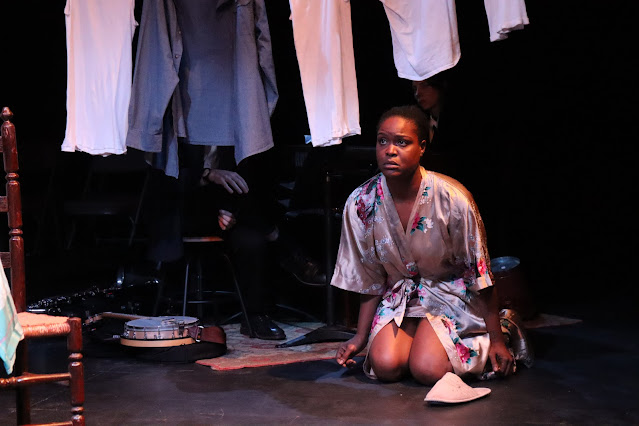Review: Don't Pass Up This "Bad Penny"
Bad Penny
Written by Mac Wellman
Directed by Kristan Seemel
Presented by The Flea Theater
20 Thomas St., Manhattan, NYC
August 24-October 7, 2019 [extended through October 13, 2019]
 |
| Joseph Huffman
(far left), Emma Orme (left), Bailie de Lacy (right), Lambert Tamin (far right). Photo by Allison Stock |
Bad Penny was originally performed, in 1989, at Bow Bridge in Central Park. Thirty years on, it is the first production to be staged in the Flea's outdoor courtyard, "The Pete." Astroturf, a cabana bar, and a game of beanbag toss lend the performance space some of the atmosphere of a park, as do the various chairs, benches, and mats placed throughout for audience seating. The cast moves freely around the space, sometimes creating multiple points of focus or even, individually, briefly engaging an audience member in the background. Often, characters unleash whirlwinds of overlapping dialogue, sometimes directed to another character and sometimes not, and all of this creates an energizing experience that, given the absurdist bent of the play, is one of immersion if not of verisimilitude.
An experimental play, Bad Penny is less interested in plot than in theme and the play of language. At the center of the play are a woman, Kat (Emma Orme), who worries about having picked up a bad penny (the kind that is face-down on the ground), and a man, Ray (Joseph Huffman), who has had a flat tire outside the east side of the park. Two more men (Alex J. Moreno and Lambert Tamin) insert themselves into the random encounter between Kat and Ray, both calling Ray a liar or crazy for his account of his motoring troubles, and a second woman (Bailie de Lacy, sounding like Carol Kane on The Unbreakable Kimmy Schmidt) involves herself in short order, defending Ray while criticizing the third man (Tamin) and laying out the boundaries of how "normal" people behave. Among the ensuing interchanges, we learn something about Ray's growing up in Big Ugly, Montana, and Kat's "gruesome" childhood in an undesirable part of the city; the second man (Moreno), prompted by Kat's poetic opening ruminations about the reality of the sky, expresses his feelings of insignificance in the face of an uncaring universe and unchanging heavens; and the second woman turns out to be a bit conspiracy-minded. There is also a Chorus (Caroline Banks, Dana Placentra, and Katelyn Sabet), who bring to mind the Weird Sisters or the Fates, and the play takes a couple of (further) unexpected turns that we won't spoil here except to say that one involves a terrific piece of staging (the awareness of which you could watch make its way unevenly through the audience) and another involves a selection of unusual hats and a bracing cacophony of proverbs.
One of the overarching themes that emerges is incomprehensibility. Kat, who associates herself with myth or the mythic and lost things, asserts that some things just inescapably escape us, even if that means that they slowly lead to a kind of madness (by this point, the magnetic Orme has adopted the intensity of a preacher on the heights of a picnic table). The play at least partly embodies the incomprehensible in the Boatman of Bow Bridge (Ryan Wesley Stinnett), a cross between a bridge troll and Charon, reputed to ferry those who pick up (or, to him, steal) his bad pennies to hell. Kat believes in the Boatman. Ray does not. Ray believes in tangibles such as money and muscle and denies the intangible, with the exception of power. Bad Penny explores this conflict and its implications for contemporary life with humor, unpredictability, a dash of creeping dread, and bouts of exhilarating rhetorical excess. In short, Bad Penny is absurdist theater at its most exciting.
-John R. Ziegler and Leah Richards




Comments
Post a Comment